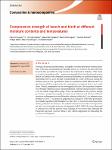Thông tin tài liệu
Thông tin siêu dữ liệu biểu ghi
| Trường DC | Giá trị | Ngôn ngữ |
|---|---|---|
| dc.contributor.author | Al-musawi, Hajir | - |
| dc.contributor.author | Huber, hristian | - |
| dc.contributor.author | Grabner, Maximilian | - |
| dc.date.accessioned | 2023-09-14T02:39:51Z | - |
| dc.date.available | 2023-09-14T02:39:51Z | - |
| dc.date.issued | 2023 | - |
| dc.identifier.uri | https://link.springer.com/article/10.1007/s10853-023-08882-w | - |
| dc.identifier.uri | https://dlib.phenikaa-uni.edu.vn/handle/PNK/8990 | - |
| dc.description | CC-BY | vi |
| dc.description.abstract | Owing to increased environmental demands to replace petroleum-derived materials with more environmentally friendly materials, research has been directed towards the potential of using wood in the automotive industry. This study extensively investigates the compressive strength (fc) of two hardwood species (beech and birch) with different anatomical directions, at various moisture and temperature levels, in an attempt to understand the wood’s behaviour during the forming process. The experimental tests were performed at 20, 100 and 140 °C on specimens with five moisture levels, ranging from completely dry to wet conditions. Overall, irrespective of the investigated direction, the measured compressive strength exhibited a clear exponential trend with increasing moisture content over the whole temperature range. This was capitalised on to present a simple predictive equation to roughly estimate the fc of beech and birch in different moisture and temperature conditions by relating to their dry fc at a reference temperature of 20 °C. | vi |
| dc.language.iso | en | vi |
| dc.publisher | Springer | vi |
| dc.subject | Compressive strength | vi |
| dc.title | Compressive strength of beech and birch at different moisture contents and temperatures | vi |
| dc.type | Book | vi |
| Bộ sưu tập | ||
| OER - Khoa học Vật liệu, Ứng dụng | ||
Danh sách tệp tin đính kèm:

